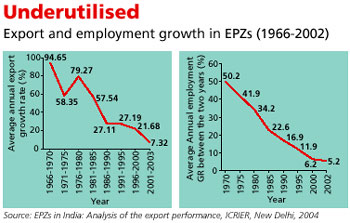Scratched record
 India's first special export processing zone, the precursor to today's sezs, was established in Kandla, Gujarat, in 1965. In 1973 came the Santa Cruz epz in Mumbai. It was only in the 1980s that India set up five more such enclaves in Noida, Falta, Kochi, Chennai and Visakhapatnam. This was when both India and China were trying to open up to the world. In 1980, China passed its first sez law, setting up the Guangdong sez. Even though India was way ahead in conceptualising sezs, China has sprinted past (see box: Elephant and dragon).
India's first special export processing zone, the precursor to today's sezs, was established in Kandla, Gujarat, in 1965. In 1973 came the Santa Cruz epz in Mumbai. It was only in the 1980s that India set up five more such enclaves in Noida, Falta, Kochi, Chennai and Visakhapatnam. This was when both India and China were trying to open up to the world. In 1980, China passed its first sez law, setting up the Guangdong sez. Even though India was way ahead in conceptualising sezs, China has sprinted past (see box: Elephant and dragon).
China got the better start, because in the initial phase of special zones in India, there were policies to facilitate operations, but implementation was flawed and no procedural or legislative changes were made, even though performance began to slide (see graph: Underutilised).Then the exim policy (1997-2002) launched the sez scheme in 2000, with the explicit objective of providing the back-up epzs had not been given. By 2003, epzs had been converted to sezs.
There is a catch, however. The failure of epzs was not just about implementation failures. The aim of epzs was to promote exports and boost foreign exchange earnings. But as things panned out, epzs turned into zones in which value was merely added to semi-finished goods for exports
